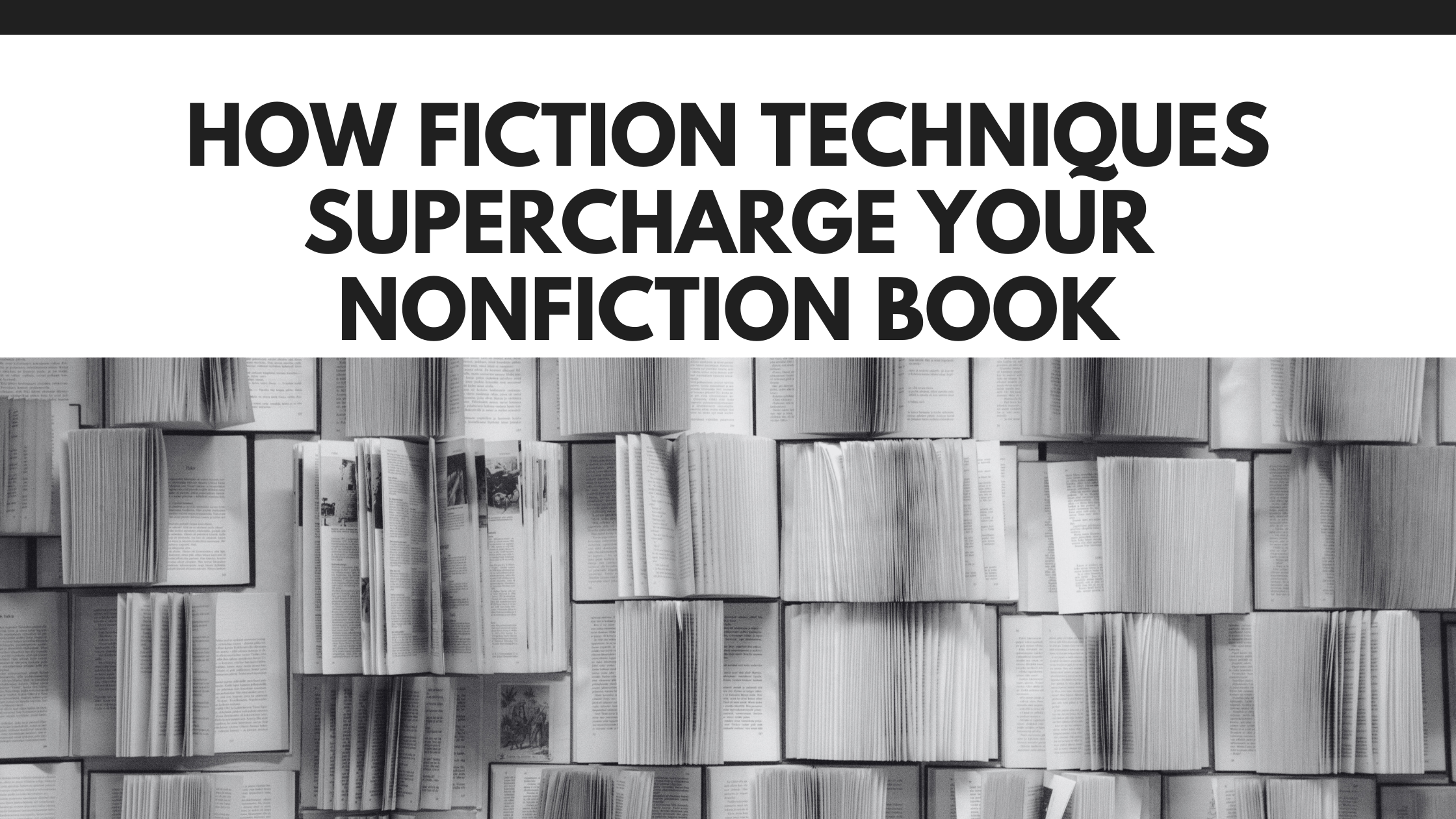Have you ever read a Malcolm Gladwell book? He’s the author of five New York Times bestsellers, including his newest book, Revenge of the Tipping Point. In writing circles, his name references the strategy of using a story at the beginning of a chapter to pull the reader in. Some of my favorite nonfiction authors do this, and it’s a style of writing I try to emulate whenever I can. (Imitation is the best form of flattery, right?). I even took Gladwell’s storytelling Masterclass once upon a time because I wanted to improve my craft.
When I speak to authors considering hiring me to coach them or write their book I hear some version of “I have all these ideas, I just don’t know where to start.” If every time you sit down to write, it feels like you’re assembling an IKEA dresser with no instructions, one screw, and a single Allen wrench made of regret. I’d urge you to pull a Malcolm and start with a story.

The Truth About Nonfiction
We all sat in classes reading dry textbooks from time to time, right? There is this pervasive idea that nonfiction should be prescriptive, packed with information, and without the fluff. It can be all those things, but the best nonfiction, the kind that lingers, gets under your skin, makes you laugh, cry, and maybe buy the author’s other book, isn’t just packed with facts.
It tells a darn good story.
So what if we took a few tricks from fiction writers, those wild souls who create entire worlds from scratch, and used them to give our nonfiction some teeth, some heart, some grit? You don’t have to be writing a short story or a first novel to use these tools. You just have to be willing to think a little differently about your writing process.
Let’s dig in.
Step 1: Treat Your Reader Like They Matter (Because They Do)
Fiction writers know they’ve got seconds to grab you by the collar. Nonfiction writers? Sometimes we think we can get away with a slow, meandering stroll through “why this matters.”
Nope. Not anymore.
Open strong. Use story. Paint a scene. Give us the stakes. Even in a nonfiction book, you need a main character (maybe that’s you, maybe it’s your client, maybe it’s a composite of all the people you’re trying to help), and you need us to care what happens to them. The story makes the message stick.
Brainstorming tip: Ask yourself, “Where was I (or they) when this whole thing started to change?” Start there.
Step 2: Think in Arcs, Not Just Chapters
A list of tips is helpful, sure. But it won’t keep your reader up at 2AM highlighting passages on their Kindle like it’s a spiritual awakening.
So steal a fiction tool: structure.
Even if you’re writing about productivity or grief or parenting with a chronic illness, your first draft will be better if you think in terms of story structure—setup, struggle, resolution. What journey is your reader on? What transformation do you want to guide them through?
Use subplots if needed (maybe you interweave your own experience with client stories). Write a synopsis like fiction writers do. Create a roadmap, of where each chapter takes the reader.
Step 3: Don’t Just Teach, Show
Fiction writers (at least the good ones) know how to show, not tell. This phrase is tossed around so often in writing circles that it causes some folks to roll their eyes, but learning to master this takes time.
Want your reader to understand burnout? Don’t define it. Tell us about the day your client fell asleep on a Zoom call with her mic on and a cold cup of coffee balanced on her laptop.
Use sensory detail. Use scenes. Bring in backstory when it deepens the message. This doesn’t just help with engagement, it also boosts credibility and connection, which is probably why you’re writing the book in the first place.
Step 4: Write the Messy First Draft, Then Shape It Like a Sculptor
When I talk about this with nonfiction authors I often hear fears that they won’t be able to tell stories and get all their ideas across in the 70,000 word count limit preferred by the publishing industry. I get it. It can seem daunting. But, if you don’t have a first draft you are worrying about things out of order. Trust the editing process.
Fiction writers know: the magic isn’t in the first round. It’s in the revisions, where you dig through the rubble and find what’s worth polishing. Don’t edit while writing. Just start writing, and get your stories and your teaching down. Fill in the rest (or delete the excess) later with the help of an editor.
Treat your nonfiction with the same care. Shape the story. Refine the pacing. Kill the clichés. Reword the jargon to be more reader-friendly. Ask yourself: does this chapter move the story forward? If not, cut it, or rewrite it until it does.

A Few Fiction Techniques to Try in Your Nonfiction
These are a few of my favorite writing techniques, though there are so many others. This article isn’t a creative writing degree, so I’ll limit myself to 8 that are easy to leverage and guaranteed to draw your target audience into your writing. I’ve included examples from my own writing to illustrate each one.
Internal Monologue
Let us inside the head of the narrator—especially if that’s you.
“To my left, an elderly man moaned in pain, clutching his chest. Sitting there, folded into a wheelchair, I thought, “What is happening to me? Why can’t I move? Will I ever talk again?” (The Power of The Pivot)
Why it works: Internal thoughts reveal vulnerability and invite empathy.
Foreshadowing
Drop hints early that pay off later. It could be as small as a phrase that circles back in the conclusion, or as big as a twist in the journey.
“That April, my mother did something that I’d do several months into my battle with Chronic Inflammatory Demyelinating Polyneuropathy and Myasthenia Gravis.” (The Power of The Pivot)
Why it works: It builds curiosity and keeps people reading.
Motifs and Symbols
Fiction writers use recurring images or phrases (like a red coat, or a specific quote) to anchor meaning.
““I’m not good at anything else!” I flung the walker across the living room. It landed with a clatter against the wall.” (The Power of The Pivot)
Why it works: Symbolic repetition creates emotional payoff without hitting readers over the head. In The Power of the Pivot, I use a walker to represent the life I lost, and the walker becomes the target of my frustration.”
Pacing
Just like in thrillers, pace your nonfiction strategically.
Short paragraphs/sentences = urgency or emotion.
“Now, I was told I should just go find another job somewhere as if reconstructing an entire life is that easy.
I couldn’t stand for more than 30 minutes without rest.
I couldn’t walk without my legs giving out.
I couldn’t chew, and swallowing often resulted in choking. “ (The Power of The Pivot)
Longer, reflective sentences = insight or gravitas.
“I applied for jobs, got offers, and had those offers rescinded when I disclosed my need for workplace accommodations. We can call this discrimination and shout about how it’s unfair, and we’d be right. But we still have to live in the world as it is. The working world is not built for those of us with chronic illness or other physical disabilities. “ (The Power of The Pivot)
Use pacing changes when you’re moving between action-packed scenes and reflective insight.
Dialogue (Real or Reconstructed)
Use conversations, even loosely reconstructed ones, to add tension, clarity, and human dynamics.
This excerpt is from an article I wrote about raising girls:
“Mama, watch my muscles,” her foam weights lifted above her head, ribs poking out of her skinny abdomen.
“You are strong, my love,” I raise my dumbbell in a bicep curl as I lower my legs into a squat.
“Mama, we exercise to take care of our bodies,” she curls in step with me.
“Yes, and we’re lucky we get to move like this,” I dance around between sets, wiggling my hips with joy and humor.
Why it works: Readers lean into dialogue. It breaks up exposition and creates motion.
The Rule of Three
Fiction and comedy both love threes—it’s just how our brains work.
“No legs. No arms. No neck. I didn’t even have words. I’d always had words. They were the one constant in my life.“ (The Power of The Pivot)
Why it works: It sounds intentional, rhythmic, and polished, without feeling formulaic.
Unreliable Narrator (for Perspective Shifts)
This is subtle in nonfiction, but it’s powerful when you revisit a moment with new insight.
“My biggest mistake was not seeing myself as a professional for far too long… I did this because, in my mind, you were a true professional only when others in the field recognized you as good enough. I shudder when I think of that now.” (The Power of The Pivot)
Why it works: It lets the reader evolve with you. Perspective becomes part of the transformation.
Sensory Language
Bring in the five senses, especially for memoir-style or reflective nonfiction. Paint a visceral world. Jefferson Fisher does this expertly in the prologue of his book The Next Conversation. His words help us feel the scratchy old carpet just before he tells us how and when he learned the importance of communication.
“The sand on the shore of Lake Michigan hadn’t shrugged off its winter chill. We streaked across it, heedless of the sand filling our sneakers to lob our dyed Easter eggs into the waves. One after another the pastel creations flew through the sky and cracked the surface of the water, disappearing into the rocky bottom.” (The Power of The Pivot)
Why it works: Sensory detail grounds abstract ideas in real human experience.
You’re Allowed to Be a Little Bit Magical
Whether you’re working on your first book, your fifteenth, or just trying to overcome that familiar writer’s block, you’re allowed to write nonfiction that lives, breathes, and maybe even swears a little.
Let your writing tools include dialogue, stakes, arcs, character development, and a little suspense.
Your nonfiction doesn’t have to sound like an instruction manual. It can sound like you, a little messy, a lot passionate, and wildly worth reading.
Next time you head to your writing space, whether it’s a corner of your kitchen, your kid’s old desk, or a coffee shop with suspicious WiFi, just start. Write the thing. Add some story, sprinkle in a little creative flair, and then trust your editor to help with the rest.
Want to add some structure to your hunt for the best stories for each of your ideas? Use our Book Writing Starter Kit.
Want some help adding a bit of narrative flair to your writing? Set up a free consultation.


